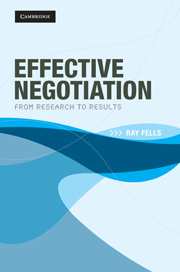Book contents
- Frontmatter
- Contents
- Acknowledgements
- 1 An introduction to negotiation
- 2 The essence of negotiation
- 3 Being strategic
- 4 The process of negotiation
- 5 Managing a negotiation
- 6 Dealing with differences
- 7 Exploring options
- 8 The end-game exchange
- 9 Negotiating on behalf of others
- 10 Cross-cultural negotiations
- Appendix 1 A preparation checklist
- Appendix 2 A negotiation review checklist
- Appendix 3 Self-reflection tools
- Appendix 4 The Strategy Framework
- Appendix 5 The Nullarbor Model
- Appendix 6 Managing competitiveness
- Appendix 7 Managing workplace negotiations
- Appendix 8 Managing a business negotiation
- Appendix 9 A culture checklist
- References
- Index
Appendix 1 - A preparation checklist
- Frontmatter
- Contents
- Acknowledgements
- 1 An introduction to negotiation
- 2 The essence of negotiation
- 3 Being strategic
- 4 The process of negotiation
- 5 Managing a negotiation
- 6 Dealing with differences
- 7 Exploring options
- 8 The end-game exchange
- 9 Negotiating on behalf of others
- 10 Cross-cultural negotiations
- Appendix 1 A preparation checklist
- Appendix 2 A negotiation review checklist
- Appendix 3 Self-reflection tools
- Appendix 4 The Strategy Framework
- Appendix 5 The Nullarbor Model
- Appendix 6 Managing competitiveness
- Appendix 7 Managing workplace negotiations
- Appendix 8 Managing a business negotiation
- Appendix 9 A culture checklist
- References
- Index
Summary
Preparation is vital in any negotiation. The questions below, which are based on the definition of negotiation provided in Chapter 1, are a useful starting point in developing a broad understanding of what a forthcoming negotiation might involve.
Two parties:
who are the parties involved?
are there any constituencies in the background?
is anyone being left out of the negotiations?
can we usefully change the structure of the negotiation?
With differences:
what are the conflicts of interest?
where are they coming from?
what do we really want from these negotiations?
why?
what don't we know about the negotiations but would really like to know?
Which they need to resolve:
what are the alternatives to reaching an agreement?
for us?
for them?
Trying to reach agreement:
how will the negotiations be handled?
how might trust and reciprocity be developed?
Through exploring options:
what are some possible creative solutions?
And exchanging offers:
how will any closing tensions be managed?
And an agreement:
what will a good agreement look like?
are there any other negotiations which are consequent upon this one?
- Type
- Chapter
- Information
- Effective NegotiationFrom Research to Results, pp. 173Publisher: Cambridge University PressPrint publication year: 2009



